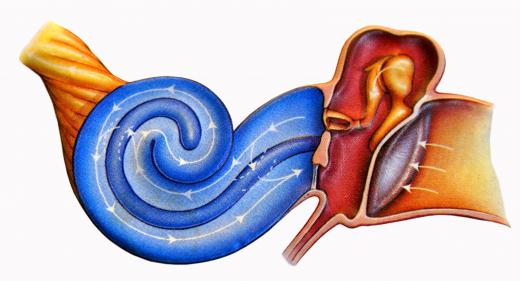What is an Acoustic Wave?
An acoustic wave is an oscillation of pressure that travels through a solid, liquid, or gas in a wave pattern. It transmits sound by vibrating organs in the ear that produce the sensation of hearing. Also called sound waves, they are defined by three characteristics: wavelength, frequency, and amplitude.
The wavelength is the distance from the top of one wave’s crest to the next. The frequency is the number of waves that pass a point each second. Sound waves with higher frequencies have higher pitches than those with lower frequencies. Amplitude is the measure of energy in a wave and affects its volume. The greater the amplitude of an acoustic wave, the louder the sound.

These waves are what allow humans and other animals to hear. A person’s ear perceives the vibrations of an acoustic wave and interprets it as sound. The outer ear, the visible part, is shaped like a funnel to collect sound waves and send them into the ear canal, where they hit the ear drum, which is a tightly stretched piece of skin that vibrates in time with the wave. The ear drum starts a chain reaction and sends the vibration through three little bones in the middle ear that amplify sound. Those bones are called the hammer, the anvil, and the stirrup.

From here, the vibrations are turned into electrical impulses that the brain can interpret. The stirrup bone presses against the fluid-filled cochlea, or hearing organ, in time to the wave. The fluid inside the cochlea moves because of the stirrup bone’s pressure, and in turn, moves a hair-cell-lined membrane buried within the fluid.
The hair cells move according to the pattern of the acoustic wave, sending signals to nerve cells that carry their interpretation of the wave to the brain. The brain interprets the signals as sound and, as a result, people hear. The human brain likes patterns, and it is interesting to note that it interprets regular sound wave patterns as pleasant and irregular wave patterns as nothing more than noise.
AS FEATURED ON:
AS FEATURED ON:















Discussion Comments
It's worth noting that even through a single substance, lower-pitched acoustic waves travel much farther than higher-pitched ones. For example, you may have shouted someone from a distance, only for them not to notice you. However, no one for miles around fails to notice the low-frequency rumble of a thunderclap. Perhaps sports events should start using large gongs instead of air horns!
@bce5mc - Yep. The more dense a substance is, the faster and farther acoustic waves will travel through it. This means that, contrary to what you might guess, sound travels farther through water or a solid wall than it does in air. Tin can telephones work on this principle.
However, that doesn't necessarily mean that you'll hear a sound better if it travels through a solid object. When sound waves transfer from one material to another, some of the wave energy gets reflected back or spread out. Low frequencies survive this process better than higher frequencies. That's why things sound muffled when coming from another room, and why you often hear only the lowest bass blasting out of a neighboring car's stereo system.
The article mentions that acoustic waves can travel through solids, liquids, and gases. I've noticed that sounds you hear underwater or from another room sound completely different than sounds coming directly from open air. Do different materials affect the sound waves traveling through them differently?
Post your comments